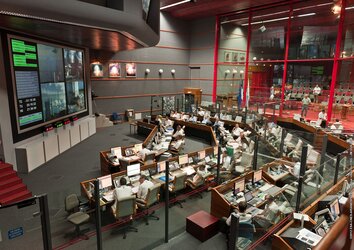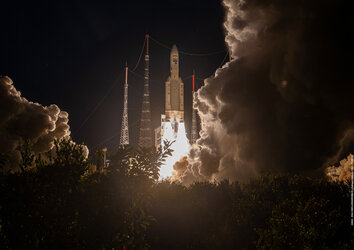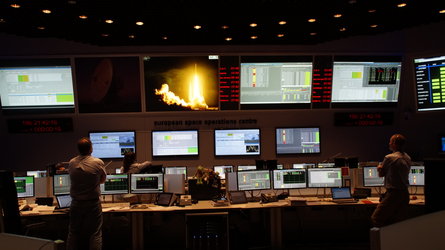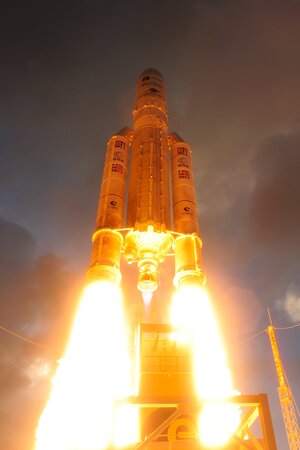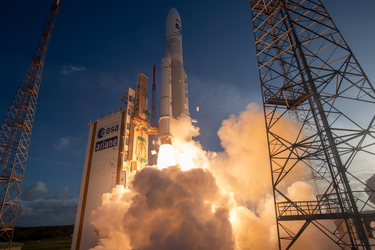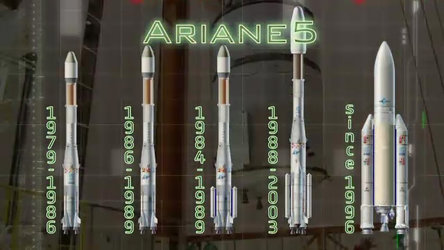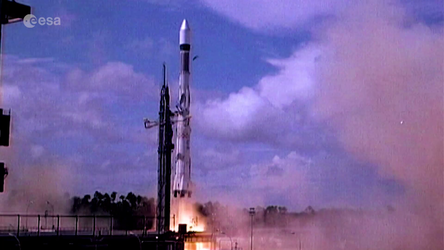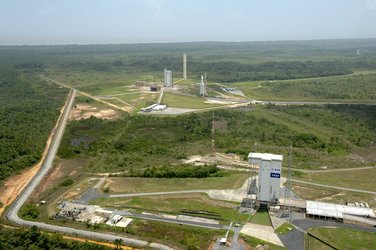Ariane 5 ECA

ESA’s Ariane 5 ECA (Evolved Cryogenic, model A), manufactured by ArianeGroup, completed over 75 launches from Europe’s Spaceport in French Guiana since 2002. It was 53 m high and 5.4 m diameter with a mass at liftoff of 780 tonnes for a dual satellite launch.
Ariane 5 ECA missions
Ariane 5 ECA was designed to deliver payloads, mainly communications satellites, with a mass of more than 10 t into geostationary transfer orbit (GTO), including the supporting structure and adaptors. The Ariane 5 ECA could launch one, two or three very large satellites. A dual launch configuration was the most commonly used.
This version of the launcher maintained Europe’s competitiveness in the commercial space transport sector by offering customers the opportunity to launch a wider range of heavier satellites.
Owing to its performance and flexibility to adapt to different missions requirements, Ariane 5 ECA was also used by institutional customers for non-GTO missions. For example, it launched ESA’s Herschel and Plank scientific missions in 2009 to the second Lagrangial point (L2), and Rosetta and BepiColombo to an Earth escape orbit in 2004 and 2018. In 2021, Ariane 5 launched the James Webb Space Telescope on its way to L2.
Ariane 5 ECA elements
This launch vehicle configuration consisted of three parts.
1. Lower composite (EAP and EPC)
The lower composite comprised:
- Two boosters (EAP: Etage d’Accélération à Poudre): 3 m diameter, 31 m high, each with 240 t of solid propellant, together providing 1200 t of thrust at liftoff. The maximum thrust during flight could reach 1300 t. EAP burned for about 135 s. After separating from the main stage they reentered the atmosphere above the Atlantic Ocean.
- The cryogenic main core stage (EPC: Etage Principal Cryotechnique): 5.4 m diameter, 30 m high, containing 175 t of propellants (25 t of liquid hydrogen and 150 t of liquid oxygen), with the Vulcain 2 engine providing 136 t of thrust. EPC operated for about 540 s. It also provided roll control during the main propulsion phase. At shut down, EPC separated from the upper composite at an altitude between 160 km and 210 km, depending on the mission’s trajectory, and performed a destructive reentry in the atmosphere over the Atlantic Ocean.
- Total liftoff thrust was about 1340 t.
The Vulcain 2 engine was ignited first. A few seconds later, when it reached its nominal operating level, the two solid-propellant boosters were fired.

2. Upper composite (ESC-A, VEB and supporting structure)
The upper composite comprises:
- The cryogenic upper stage (ESC-A: Etage Supérieur Cryotechnique de type A) with 14.7 t of propellant (liquid hydrogen and oxygen). The reliable HM7B engine provided 6.5 t of thrust and was reused from Ariane 4’s third stage. It operated for about 945 s and also provided attitude control during the propulsion phase and the separation sequences of the payloads.
- The Vehicle Equipment Bay (VEB-C), ‘the brain’, autonomously controlled the whole vehicle. Its structure was made of composite material. The VEB transmitted all key flight parameters to the ground station network.
- The supporting structure interfaced with the payload. This conical adaptor was mounted on top of the VEB and provided the standard 2624 mm diameter interface with the payload adaptor.

3. Launcher upper part (fairing and Sylda 5)
The launcher upper part comprises:
- The fairing protecting the payload at liftoff and during atmospheric flight (5.4 m diameter, 17 m high). The fairing was split by two pyrotechnical commands and jettisoned more than 3 minutes after liftoff, at an altitude above 100 km.
- The structure accommodating the lower and upper satellites, Sylda 5 (Système de Lancement Double Ariane 5): 4.6 m diameter and height varied from 4.9–6.4 m in increments of 0.3 m. Six versions accommodated the various sizes of satellites.
Ariane 5 ECA typical launch sequence for GTO missions




